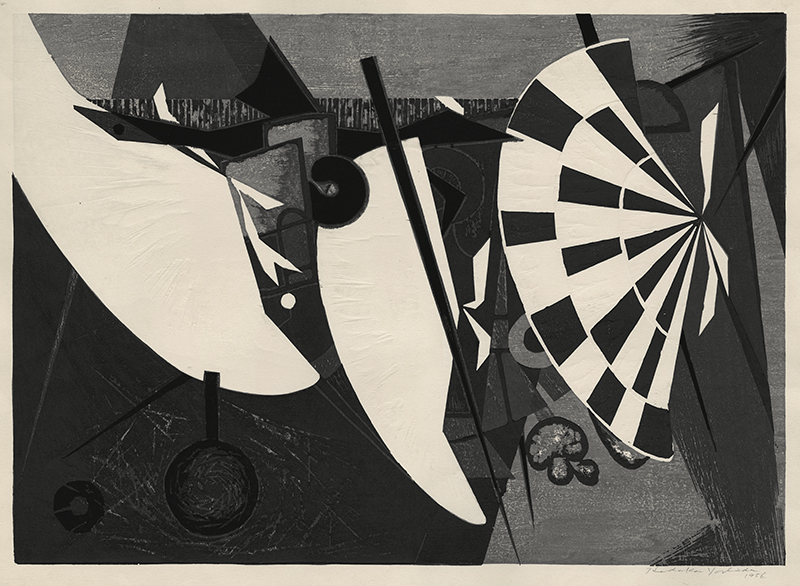This untitled work is a color woodcut with gauffrage from 1956 by Japanese artist Hodaka Yoshida. It is from the series Primitive Energy Prints and was printed by the artist on ivory Kizuki-hosho. Hodaka’s prints from this period were not printed in a special edition. This woodcut is pencil signed and dated and the image measures 13-3/4 x 19-3/16 inches.
This dynamic abstract woodcut in blacks and gray with gauffrage elements was created in 1956, after Yoshida traveled to the United States, Cuba, and Mexico. Between 1955 and 1963, Hodaka produced a series of woodcuts he called Primitive Energy Prints, abstractions based upon Pre-Columbian primitive forms but replete with motion.
Hodaka, son of printmakers Hiroshi and Fujio Yoshida and younger brother of printmaker Toshi Yoshida, became a printmaker, against his father's wishes. He said “My father's opposition made me an abstract artist, I've always liked Miro and Klee, but I don't know that either has been a concrete influence...I started to make prints around 1950 and I've carved and printed my own from the beginning.”
In an interview with Ronald Robertson, Yoshida spoke about his process: “I start with a vague idea or emotion which I try to visualize from various angles or points of view. Occasionally I succeed on fixing it as a clear image, but the original idea often develops into another object...An action inspires me with an idea which decides or stimulates the next action. Forms and colors thus produced are gradually organized into a picture….Sometimes, I find, quite by chance, in an automatic drawing, a part of a sketch or stains on paper that which I had been looking for, and then I begin to work it out into a definite image.”
Hodaka Yoshida, painter, printmaker and teacher, was
born in Tokyo, Japan on 3 September 1926, into the noted Yoshida family of
artists. Father Hiroshi and mother Fujio were pioneers in embracing Western
style in pre-war Japan, building a major collector clientele in America and
England in the 1920s and 1930s. Before the Second World War, their children
were encouraged to carry on this tradition. Toshi and Hodaka studied oil
painting and woodcut at Daichii High School, considered the best in Japan at
the time.
Once the war ended, the future of the Yoshida family studio was uncertain,
having lost its largest clientele after the Pearl Harbor attack and Japan's collaboration
with Axis powers. It was expected that Hodaka, being the second eldest son,
would set aside his pursuit of art and find an occupation that would guarantee financial
stability. At his father's request, Hodaka began studying biology at age
nineteen.
Defying his parents' wishes, he soon left school to pursue studies in woodblock
and painting and participated in his first exhibition in 1948 at the Second
Nihon Independent Exhibition. Like his parents before him, Hodaka was influenced
by Western art and it was the rising stars of Abstraction and Surrealism that
caught his attention. His work was well received and he began exhibiting
frequently throughout Japan along with his wife, artist Chizuko Inoue
(Yoshida). By the mid 1950s, Hodaka was exhibiting in Mexico and the United
States. In 1952, he became a member of the Japanese Print Association, and his
teaching career began when he took posts at universities in Hawaii and Oregon
in 1957.
Hodaka’s work went through several distinct stylistic periods: Abstraction and
Cubism, Buddhist and Primitive Japanese folk art, Pop Art, and Surrealism. He
worked in oils, etching, engraving, lithography, serigraphy, and photo-transfer
techniques. At each evolution, Yoshida's work was embraced by critics worldwide.
Yoshida exhibited at the print biennales in Tokyo, Krakow, Ibiza, and
Ljubljana. In 1981 he organized the major Japanese Print Association
exhibition, 25 Years of World Exhibition
of Modern Print Art in Tokyo, and in 1995, he was posthumously awarded
Japan's Order of the Rising Sun. Hodaka Yoshida died in November of 1995.
Yoshida's work is held in the collections of the Museum of Fine Arts Boston,
Massachusetts; the Brooklyn Museum, New York; the Harvard Art Museums, Cambridge,
Massachusetts; the Art Institute of Chicago, Illinois; the Cleveland Museum of
Art, Ohio; the Nelson Atkins Museum of Art, Kansas City, Missouri; the Los
Angeles County Museum of Art, California; the Metropolitan Museum of Art and the
Museum of Modern Art, New York; the Portland Art Museum, Oregon; the Fine Arts
Museums of San Francisco, California; the National Museum of Asian Art, Washington,
D.C.; and in Japan in the Hiroshima Contemporary Art Museum; the Museum of
Modern Art, Kamakura & Hayama; the Machida City Museum of Graphic Arts, the
Museum of Contemporary Art, and the National Museum of Modern Art, Tokyo.



